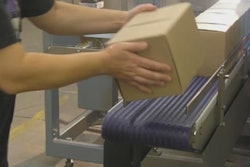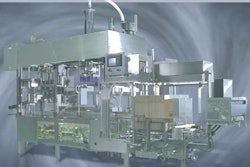
PW: What percentage of packaging machinery do you estimate incorporates robotic technology?
Senti: I believe that robotics represent less than 7 percent of packaging machinery being used today. Although this figure is relatively small, I expect that it will grow almost exponentially within the next three to five years. The initial breakout stage for robotics has already passed, and these technologies are becoming widely accepted in a number of industries. As a result, first-time users are going to significantly boost demand for robotic technologies in the short term; in the long term, this demographic represents the foundation for a much greater establishment of robotics in packaging.
For this reason, major industry tradeshows like PACK EXPO are essential for introducing robotic technology to non-robot users. These shows help develop the robotics field by showcasing how robots are being applied in various industries and helping to foster new understanding and innovation among developers.
PW: What markets represent growth areas for robotic technology?
Senti: Food and beverage are two industries with enormous growth potential for robotics in the coming years. These industries are just beginning to see the benefits of robotics for secondary packaging and palletizing. Additionally, robot manufacturers continue to introduce high-speed sanitary robots for upstream product handling. These robots will be used more frequently in the handling of raw foods, such as unprocessed meats and vegetables, and will possess the versatility for both upstream packaging applications and infeed handling/orienting for downstream processes.
In the beverage industry, where very traditional packaging equipment tends to be used, robots present a great opportunity for enhanced efficiencies. Able to provide higher reliability, greater flexibility, reduced changeover, continuous and/or intermittent packing and a smaller footprint along the packaging line, robots are expected to increase substantially in popularity among beverage producers over the next few years.
Instead of being solely market-driven, however, robotic technology is more often driven by the desire to simplify solutions by replacing unreliable and complicated mechanical configurations. Primary packaging, including cartoning for food/beverage, pharmaceutical and healthcare products, is a good example. We will see this trend accelerate in the future.
Robotic automation is also being used for mixed cases. Containing multiple brands or product types, these cases require a higher degree of accuracy than traditional packaging technologies can provide.
PW: What other types of packaging applications can robotics be applied to?
Senti: Robots are also ideal for in-feed product handling, specifically for random orientation, inspection and processing into flow wrappers, cases, trays, pouches or blisters.
Palletizing is another area that requires the efficiency of robotics. Robots offer more flexibility and reliability than conventional palletizers. In addition, as manufacturers continue to eliminate the traditional pallet, robots are becoming necessary to palletize directly on the stretch wrapper. Robots are also necessary for creating mixed pallets, which contain multiple brands or product types on each level. Robotic usage in this area will continue to grow as club stores like Sam's Club, BJ's, and Costco increase demand for mixed pallets, which can be used directly at retail as in-store merchandising displays.
Robots can also be used for secondary packaging. This trend is increasing with robotic solutions that integrate collation, accumulation, and product handling. An example is eliminating flap control with 6-axis robots and incorporating pick and pack on-the-fly methods, which cannot be performed by conventional packaging machinery. In addition, robotics are starting to be used for de-casing cases/trays with conveyor tracking in order to prevent product tipping, eliminate accumulation, and control gapping.
PW: How has the appearance of packaging evolved with the help of robotics?
Senti: Dynamic marketplace changes for consumer product goods have given rise to more technologically sophisticated package designs and presentations. These changes tend to make robotics a more desirable packaging automation tool since they facilitate handling of non-conventional package shapes and materials on the production line.
In addition, due to increasingly frequent product introductions within the CPG marketplace, packagers have needed to find ways to process multiple products on the same packaging line. The packaging industry has evolved by incorporating new technologies that can deliver a higher degree of flexibility and accuracy. Robots are an effective way to meet this need, offering greater versatility, reliability and product changeover compared to conventional packaging methods. Robotic systems are in use that run hundreds of SKUs on a single line, which helps packagers enhance production efficiencies and respond to market needs. Many of these systems also provide automatic product changeover, often on-the-fly, which further boosts efficiencies.
PW: What advances in robotic technology have significantly impacted the packaging industry in the past several years?
Senti: As robotic technology has become more advanced, the price of robots has dropped, making them more widely accessible. Also, new products specifically designed for packaging automation have started to be introduced, which is making robotics a requirement on an increasing number of packaging lines.
The ease of integrating vision systems into robotics has also greatly impacted the packaging industry. Now, during mixed casing, primary/secondary packaging and depalletizing applications, robots can successfully identify and differentiate products in order to handle them correctly and accurately. This integration has helped to dramatically reduce the risk of packaging error when robots are used. Combined with a 70,000+ hour MTBF (Mean Time Between Failure) reliability rate for new robots, this feature offers a huge advantage for packagers. This system reliability can be increased dramatically when robots are used to reduce or eliminate the total number of electromechanical components.
PW: How do you see robotic technology evolving in the future?
Senti: In addition to increasing familiarity and comfort with robotic technologies among packagers, today's robots are a highly proven product, almost to the point of becoming commoditized. Although this technology will continue to evolve with additional software and robot models, in the long-term, there will be a major shift away from the robot manufacturer toward the system integrator.
Years ago, end users relied solely upon robot suppliers for application support. Today, however, there are hundreds of integrators that focus on specific industries/applications and work directly with end-users to provide integrated “solutions.” This trend will accelerate in the years to come as integrators start to assume the majority of robot placements under the solution-based sales model, which will create challenges due to a shortage of experienced robotic application and software engineers.
For robotic developers, the change to a solution-based model will mean placing greater emphasis on off-line simulation-driven design of systems and developing software tools that can ease integration for specific applications/industries.























